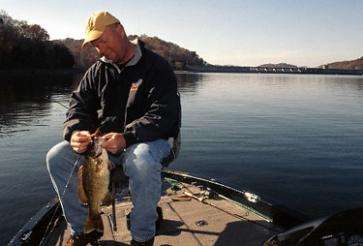
Last week I wrote about my favorite smallmouth lure — the jig. This week, I want to tell you a little about one jig application that is near and dear to my heart and an absolutely deadly way to catch brown bass right now!
It’s called the “float and fly,” and if you’ve never tried it before, you’re in for an absolute treat. Not only is it effective, but it’s fun and will take you back to your earliest days of fishing.
For starters, let’s clear up a couple of common misunderstandings involving the float and fly.
First of all, it’s not a fly-fishing technique. You don’t need a fly rod to do it, and you don’t need to be able to fly cast. The “fly” in float and fly fishing is actually just a small hair jig. “Fly” is just the word we use in my part of the country (Tennessee) to describe a hair jig. It’s been that way for as long as I can remember.
“Float,” by the way, refers to the bobber or cork that suspends the jig and keeps it up off the bottom where the fish are at this time of year. It doesn’t have anything to do with float fishing on a river or creek — though I love that style of fishing, too.
The rod you use for float and fly fishing is a long, spindly spinning rod with a very light action. You need that light action since you’ll be using very light line — usually 4- to 8-pound-test fluorocarbon — running from the float to the jig.
The perfect reel for float and fly action is a quality spinning reel with a very smooth drag. That comes in handy when you’re fighting a big, strong fish on light line. As you become more experienced with the technique, you may want to try backreeling instead of using the drag, but for beginners, the drag is definitely the way to go.
I mentioned the line going from the float to the jig because you’ll want a different type and size of line that goes between the float and your reel. That’s where I like one of the superlines like Fireline Crystal in about 8-pound test. It’s strong and casts well, but also has a nice, small diameter.
Your main line (off your reel), your leader line (going down to the jig) and your float all meet up at a three-way swivel. You’ll tie the two lines to one arm each of the swivel. Clip the float to the other arm.
By the way, the length of line between the float and the jig depends upon how deep the fish are holding. With this sort of rig and a long spinning rod (8-10 feet), I can pretty easily handle a 15-foot leader. But I’m a tall guy with plenty of practice. You might be more comfortable with shorter leaders … at least for a while.
Well, those are the nuts and bolts of the float and fly setup. It’s a terrific technique for catching smallmouth (or any other bass) when the water temperature is at the mid 50s or below and the fish are suspended below schools of baitfish.
The technique — in one form or another — has been around for decades. Crappie fishermen have used it for a long time as a way to fish jigs for suspended panfish. A Tennessee angler named Charlie Nuckols first brought it to prominence in the bass fishing world almost 20 years ago. It still works.
If you’d like to actually see the float and fly in action, check out my new float and fly video atwww.punisherlures.com. You’ll see all the elements in action and watch 5-time Bassmaster Classic qualifier Charlie Campbell use it for the very first time on Table Rock Lake in Missouri.
Until next time, if you have any questions or comments, I’d love to hear from you. Please e-mail me atStephen@thesmallmouthguru.com.





